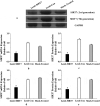Improving the repair mechanism and miRNA expression profile of tibial defect in rats based on silent information regulator 7 protein analysis of mesenchymal stem cells
- PMID: 35139764
- PMCID: PMC8973621
- DOI: 10.1080/21655979.2022.2027066
Improving the repair mechanism and miRNA expression profile of tibial defect in rats based on silent information regulator 7 protein analysis of mesenchymal stem cells
Abstract
The aim of this study was to verify the role of Silent Information Regulator 7 (SIRT7) in improving the repair mechanism of bone marrow mesenchymal stem cells (BMMSCs) and the expression of microribonucleic acid (miRNA). Human BMMSCs were extracted from patients with femoral fractures, and the proliferation activity of human BMMSCs before and after knockout SIRT7 and the expression levels of bone-related genes and proteins were compared. Thirty-two 8-week-old male Sprague-Dawley (SD) rats were randomly divided into a blank group, a chitosan scaffold group, a control group, and a silence information regulator knockout group 7 (n = 8). In addition to the blank group, the chitosan scaffold, the green fluorescent protein (GFP) transfected stem cell composite chitosan scaffold, and the SIRT7 knockout stem cell composite chitosan scaffold were implanted in the other three groups, respectively. The X-rays and small animal in vivo three-dimensional tomography (Micro-CT) were adopted to quantitatively analyze the volume fraction, the number of trabeculae, and the connection density. Compared with the other three groups, the bone defect was formed more in the medullary mesenchymal stem cell knockout group, and the bone volume fraction, number of trabeculae and connection density were significantly increased (P < 0.05). MiR-98-5p can significantly promote the formation of bone molecules and bone structure in rats (P < 0.05). Human BMMSCs combined with chitosan scaffold can accelerate the repair of tibial defects. MiR-98-5p targeting and regulating bone formation gene (CKIP-1) could significantly improve the process of osteogenesis in rats.
Keywords: BMMSCs; SIRT7 protein; miRNA; tibial defect; tibial defect model.
Conflict of interest statement
No potential conflict of interest was reported by the author(s).
Figures










Similar articles
-
[Mechanical properties and effect on osteodifferentiation of induced pluripotent stem cells of chitosan/whisker/calcium phosphate cement composite biomaterial].Zhongguo Xiu Fu Chong Jian Wai Ke Za Zhi. 2018 Jul 15;32(7):959-967. doi: 10.7507/1002-1892.201710028. Zhongguo Xiu Fu Chong Jian Wai Ke Za Zhi. 2018. PMID: 30129324 Free PMC article. Chinese.
-
Knockdown of MiR-140-5 promotes osteogenesis of adipose-derived mesenchymal stem cells by targeting TLR4 and BMP2 and promoting fracture healing in the atrophic nonunion rat model.Eur Rev Med Pharmacol Sci. 2019 Mar;23(5):2112-2124. doi: 10.26355/eurrev_201903_17255. Eur Rev Med Pharmacol Sci. 2019. PMID: 30915756
-
[Osteogenic effect of peptides anchored aminated tissue engineered bone for repairing femoral defect in rats].Zhongguo Xiu Fu Chong Jian Wai Ke Za Zhi. 2013 May;27(5):520-8. Zhongguo Xiu Fu Chong Jian Wai Ke Za Zhi. 2013. PMID: 23879086 Chinese.
-
Autologous oxygen release nano bionic scaffold composite miR-106a induced BMSCs enhances osteoblast conversion and promotes bone repair through regulating BMP-2.Eur Rev Med Pharmacol Sci. 2018 Nov;22(21):7148-7155. doi: 10.26355/eurrev_201811_16246. Eur Rev Med Pharmacol Sci. 2018. PMID: 30468455
-
Repair of bone defects in rat radii with a composite of allogeneic adipose-derived stem cells and heterogeneous deproteinized bone.Stem Cell Res Ther. 2018 Mar 27;9(1):79. doi: 10.1186/s13287-018-0817-1. Stem Cell Res Ther. 2018. PMID: 29587852 Free PMC article.
References
-
- Sagi HC, Young ML, Gerstenfeld L, et al. Qualitative and quantitative differences between bone graft obtained from the medullary canal (with a reamer/ irrigator/ aspirator) and the iliac crest of the same patient. J Bone Joint Surg Am. 2012;94(23):2128–2135. - PubMed
-
- Wubneh A, Tsekoura EK, Ayranci C, et al. Current state of fabrication technologies and materials for bone tissue engineering. Acta Biomater. 2018;80:1–30. - PubMed
-
- Bartold PM, Gronthos S, Haynes D, et al. Mesenchymal stem cells and biologic factors ioading to bone formation. J Clin Periodontol. 2019;46(21):12–32. 4 6. - PubMed
MeSH terms
Substances
LinkOut - more resources
Full Text Sources
